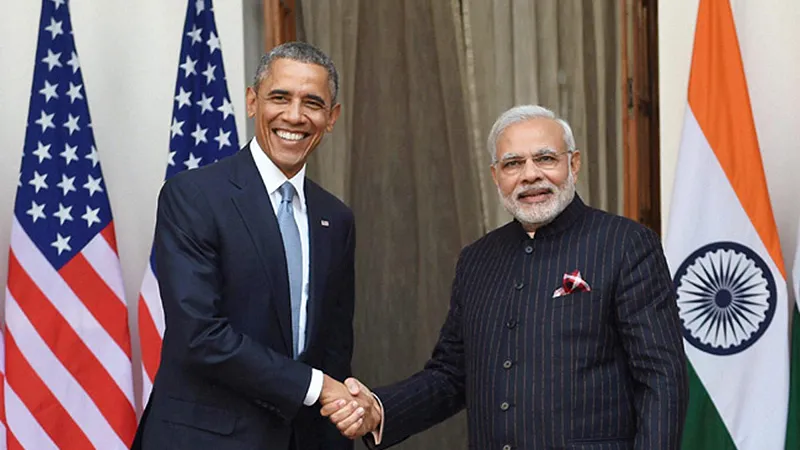The challenge a writer confronts in analysing anything Prime Minister Narendra Modi does is separating hype from achievement. And so it is with his latest US visit.
The hype, of course, remains overwhelming as does the spin. But that's the Modi style, and you need to factor it in when forming any opinion. Take the issue of the Indian entry to the Missile Technology Control Regime (MTCR).
"India becomes a member of MTCR: PM Modi's big diplomatic success" read a headline. Actually, what happened was that the moment the Supreme Court allowed the sole remaining of the two Italian marines held on murdering two Indian fishermen off the coast of Kerala in 2012 to go back home two weeks ago pending his trial, the Italian government withdrew its objection on India's MTCR membership.
The MTCR is not a gift from anyone. It was part of a deal in which the US agreed to get India into a range of technology control cartels like the MTCR and the Nuclear Suppliers Group (NSG), in exchange for:
- Putting its civil reactors under the safeguards of the International Atomic Energy Agency (IAEA),
- Agreeing not to conduct any more nuclear tests,
- Accepting the IAEA's stringent additional protocol,
- Agreeing to abide by the NSG's rules, current and future, without being an NSG member, and
- Giving significant business to American nuclear reactor companies.
We have kept our part of the bargain, now the US must reciprocate.
When you measure the visit on transactional scales — the kind you must always use in international relations — you will see it was about give and take. Notwithstanding the optics, the alleged friendship between Modi and Barack Obama has little leverage here.
Intriguingly, in the joint statement issued < class="aBn" tabindex="0" data-term="goog_570896954">< class="aQJ">on Tuesday, the words 'South China Sea' are missing. In Modi's first visit to Washington in 2014 and during Obama's visit to New Delhi in 2015, the joint statements had spoken of the need to ensure freedom of navigation and overflight throughout the Asia-Pacific region, "especially in the South China Sea".
There are three possible explanations for this omission. One, India is delicately distancing itself from the somewhat advanced position of 2014 and 2015. Two, that this is part of a bargain with Beijing whose pay-off will be the NSG membership. Three, that it is simply an oversight signifying nothing.
An interesting addition to the formulation this time speaks not only of upholding the United Nations Convention on the Law of the Sea (Unclos), ensuring freedom of navigation and overflight, but also of "exploitation of resources as per international law". This must be seen in the context of India's interests in oil blocks off Vietnam, one of which is under challenge from China.
The Modi government finally announced its agreement on the Logistics Exchange Memorandum of Agreement (Lemoa), something of primary benefit to the US Navy, since for some time to come, the Indian Navy will focus on the region between the Malacca Straits and Suez.
Additionally, India committed to join the Paris Climate Change Agreement, but without accepting any timeline. This must have disappointed the Americans since the pact is something of a legacy issue for Obama and he is keen have it ratified before he leaves office.
On defence, there is more spin than achievement. 'Major defence partner' means little, unlike, say, 'major non-Nato ally' which has a legal standing. The much touted Defence Technology Trade Initiative (DTTI) is not likely to yield much. A technology leader does not share technology for love or money. You may do it for money — as the indigent Russians do — but you do not give your cutting-edge stuff.
There important movement in cyber-security and information-sharing between the US and Indian terrorism screening authorities. But as for economics and trade, the ball remains in the court of the private sectors of the respective countries. The things that the two governments should do are simply not happening: the completion of the totalisation agreement, ironing out differences over intellectual property rights (IPR) and the Bilateral Investment Treaty.
Beyond the give and take is the emerging triangular relationship in Asia involving the US, India and China. It is in India's interest to remain a pole — howsoever weak — in this triangle, instead of becoming an adjunct to the US. By playing a balancer, New Delhi stands to gain.
And beyond the rhetoric over the South China Sea, our border dispute and Sino-Pak relations, there is a lot that China has to offer. Our interest is in steadily and surely building up our economy in the period of our opportunity — the next 20 years — and avoiding conflict to the extent we can.
In his speech to the US Congress < class="aBn" tabindex="0" data-term="goog_570896955">< class="aQJ">on Wednesday, Modi spelt out the scope and terms of our engagement. He spoke of the overall convergence between the US and India, flagged several key issues like the lack of a security architecture in Asia and the importance of isolating "those who harbour, support and sponsor terrorists" (read: Pakistan).
But he also said that "autonomy in decision-making and diversity in our perspectives can only add value to our partnership" (read: strategic autonomy).
This commentary originally appeared in The Economic Times.
The views expressed above belong to the author(s). ORF research and analyses now available on Telegram! Click here to access our curated content — blogs, longforms and interviews.




 PREV
PREV


